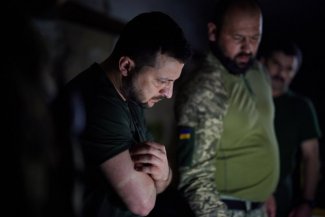Ukrainian forces prepare to defend Kupyansk. Day 533 of the war

Ukrainian forces renewed their assault south of Velyka Novosilka; after several days of fighting, they managed to establish control over the northern part of the village of Urozhayne and retook the neighbouring village of Staromayorske. According to deputy defence minister Hanna Maliar, the defenders also achieved partial success in striking towards the village of Pryutne, which lies southwest of Velyka Novosilka and is just over the border of Zaporizhzhia oblast, as well as the village of Verbove southeast of Orikhiv. The subsequent Ukrainian assaults south of that town proved unsuccessful, although on 11 August there were media reports that the defenders had managed to reach the northern outskirts of the village of Robotyne and were continuing their attack.
The news of the assaults on Robotyne conflicted with reports from the Ukrainian General Staff that the Russians had launched an attack toward Novodanylivka, which lies 8 km north of that village (on the outskirts of Orikhiv, 9-10 August). The Staff’s communiqués also reported unsuccessful Russian attempts to regain previously held positions in the area of Staromayorske. However, the Ukrainian defence ministry did not confirm reports that Ukrainian forces had attempted to ford the Dnieper near Kherson and establish a new bridgehead on the left bank.
The Russians broke through Ukrainian defences northeast of Kupiansk and entered Synkivka, and also made further advances east of the town, where Ivanivka is the defenders’ main point of resistance. On 9 August, the head of the regional military administration in Kupiansk ordered the forced evacuation of the population from villages east of the Oskil River, including the left bank part of the town; this is expected to involve a total of more than 11,000 people. Meanwhile, the Russian counterattack southeast of Bakhmut has probably pushed Ukrainian forces away from the Kuridumivka-Andriivka line to the western side of the Donets-Donbas canal, and has partially returned control over the western outskirts of Klishchiivka to the invaders. On 10 August, the Russians also carried out an attack in the area of Bohdanivka, west of Bakhmut. However, a series of clashes in the vicinity of Avdiivka and Mariinka, as well as on the border of Luhansk and Kharkiv oblasts, brought no change.
On 11 August, the Russians launched more missile attacks targeting Kyiv and the Khmelnytsky & Vinnytsia regions (local sources also reported explosions in the Ivano-Frankivsk region). The capital’s military administration, citing earlier reports by the Air Force Command that a Russian MiG-31 carrying a Kinzhal missile had started in the direction of Kyiv, reported that the city had indeed been attacked with such missiles, but all of them had been shot down. Kyiv’s authorities announced that shrapnel had fallen in three areas, while local media reported explosions near the Zhuliany airport.
On 9 and 10 August, rockets hit the city of Zaporizhzhia. In the first attack, three civilians were killed and nine wounded, while in the second one person died and 16 were injured (a hotel building was damaged; according to the city police, the Russians used an Iskander-K cruise missile). In addition, on 9 August a Russian Iskander was said to have struck Zarichne in Donetsk oblast. The Ukrainian General Staff reported a total of three enemy missile attacks on 9 August and five the following day. On 10 August, kamikaze drones destroyed a fuel depot in the Dubensky region of Rivne oblast.
The Russian side reported further kamikaze drone attacks on Moscow (9 and 11 August; the Russians reported shooting down three of them) and Kursk (11 August; two drones were destroyed). On the night of 10 August, the Ukrainians launched a massive drone attack on Crimea. Information about the explosions came from the area of Dzhankoy and from Sevastopol. According to the Russians, two of the 11 drones used in the attack on Sevastopol were shot down by air defences, and nine were neutralised by means of EW technology.
On 8 August, Germany’s Handelsblatt reported that Rheinmetall had purchased 50 Leopard 1 tanks from Belgium’s OIP Land Systems. After they are overhauled and modernised, 30 of them will be handed over to Kyiv. Earlier in the day, Belgium’s De Standaard erroneously reported that the first tanks from the Tournai depot had departed for Ukraine. On 9 August, the Chancellery Office reported that the new German delivery included two launchers for the Patriot air defence system, 10 Bandvagn 206 articulated tracked transporters, 6525 155-mm smoke shells (with incendiary charges), four Vector reconnaissance drones and 100 MG5 machine guns. A day later, Estonia’s defence ministry announced that the new military support package would include 150 small arms along with ammunition. In turn, on August 11, Der Spiegel reported “secret talks” between the German authorities and representatives of the arms industry on modifying Taurus cruise missiles so they could be sent to Ukraine without fear of them being used to attack targets in Russia.
On 9 August, the Ukrainian General Staff reported on the UK-led Interflex multinational training operation. Since the beginning of the year, 20,000 Ukrainian servicemen have received training from British, Australian, Danish, Finnish, Dutch, Canadian, Lithuanian, Norwegian, New Zealand and Swedish instructors.
On 11 August, the Washington Post published an article on the training of Ukrainian pilots on F-16 fighter jets, which said that this process will involve personnel from at most half of the squadron, and may not end until the summer of 2024. The first training group included six pilots (two remain in reserve), who will first have to undergo a four-month specialised language course in the UK (despite their fluency in English). This will delay the start of the six-month combat training period until January. In addition, Denmark is calling for the venture to be more comprehensive, including pilots and ground crew at the same time. Another such group would be ready by the end of next year. According to US officials, in addition to the eight pilots already participating, about 20 more are eligible for training, but they need to take a language course. The establishment of a training centre in Romania is still being negotiated between the Romanians and the Dutch, the key problem being a shortage of F-16 training instructors in the EU.
On 8 August the Polish Armaments Group’s president Sebastian Chwalek told the Polish news agency PAP that Polish mechanics are already present in Ukraine. Many of them are working close to the front line; as part of the PGZ Serwis Orel company, they are engaged in repairing donated weapons. Soon afterwards, material appeared on the Russian-language Internet confirming the Polish specialists’ participation in repairing Krab howitzers in field conditions. The Russian commentators located the Polish repair teams in the frontline zone in the Kharkiv region.
Referring to the report on 6 August that work at the Pokrovka-Kolotilovka border crossing point (the border between Ukraine’s Sumy oblast and Russia’s Belgorod oblast) had resumed, the minister for temporarily occupied territories of Ukraine Iryna Vereshchuk said that over the past few days about 150 Ukrainian citizens have been returning via this route each day. At the same time, she stressed that traffic across the border is only in one direction, and the Ukrainian side is not admitting anyone to Russia. Vereshchuk added that a similar “humanitarian corridor” is also in operation on the border with Belarus in Volyn oblast (Domanovo-Mokrany).
Commentary
- The presence in Ukraine of Western (including Polish) specialists involved in the day-to-day servicing and repair of armaments being used by the army there is essential to ensure their relatively uninterrupted use at the front can continue. Ukraine is suffering from a shortage of mechanics (some of whom have already been sent to the front as regular soldiers); another issue is the length of time it takes to train mechanics to maintain armaments built according to designs which differ from Soviet models. Western specialists are also working in Ukraine as instructors for the mechanics there, but their presence is crucial to maintaining the usability of the supplied armaments.. Most of them are working away from the front line, particularly those technicians servicing the Western air defence systems and the precision weapons which have ranges of at least several tens of kilometres (including the British mechanics involved in preparing the Storm Shadow missiles). However, the scope and range of the Russian missile attacks (especially the recent hit on the Starokostiantyniv air base) confirm that no location on Ukraine’s territory can be considered safe.
- As an alternative to the presence of servicemen in Ukraine, the armaments are being serviced and repaired in partner countries; this weakens the defenders’ capabilities, often for weeks at a time. One example of this is the PzH 2000 howitzers donated by Germany, Italy and the Netherlands. These weapons are extremely prone to failure in conditions of classic warfare, as they were constructed for so-called low-intensity stabilisation operations. They had to be transported from Ukraine to Lithuania for servicing, and of the 12 units delivered to Kyiv in June 2022, only two were fit for use by August. After the initial problems with servicing and repairing them, the use of the German armoured howitzers dwindled to being largely symbolic. This situation would not have occurred if maintenance could have been carried out in the frontline zone, as is the case with the Polish Krabs.






